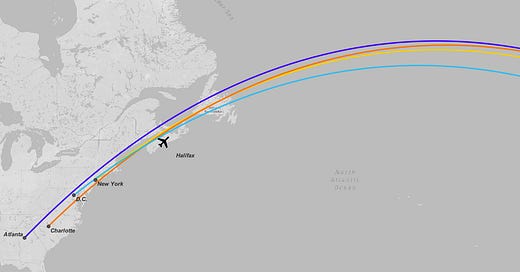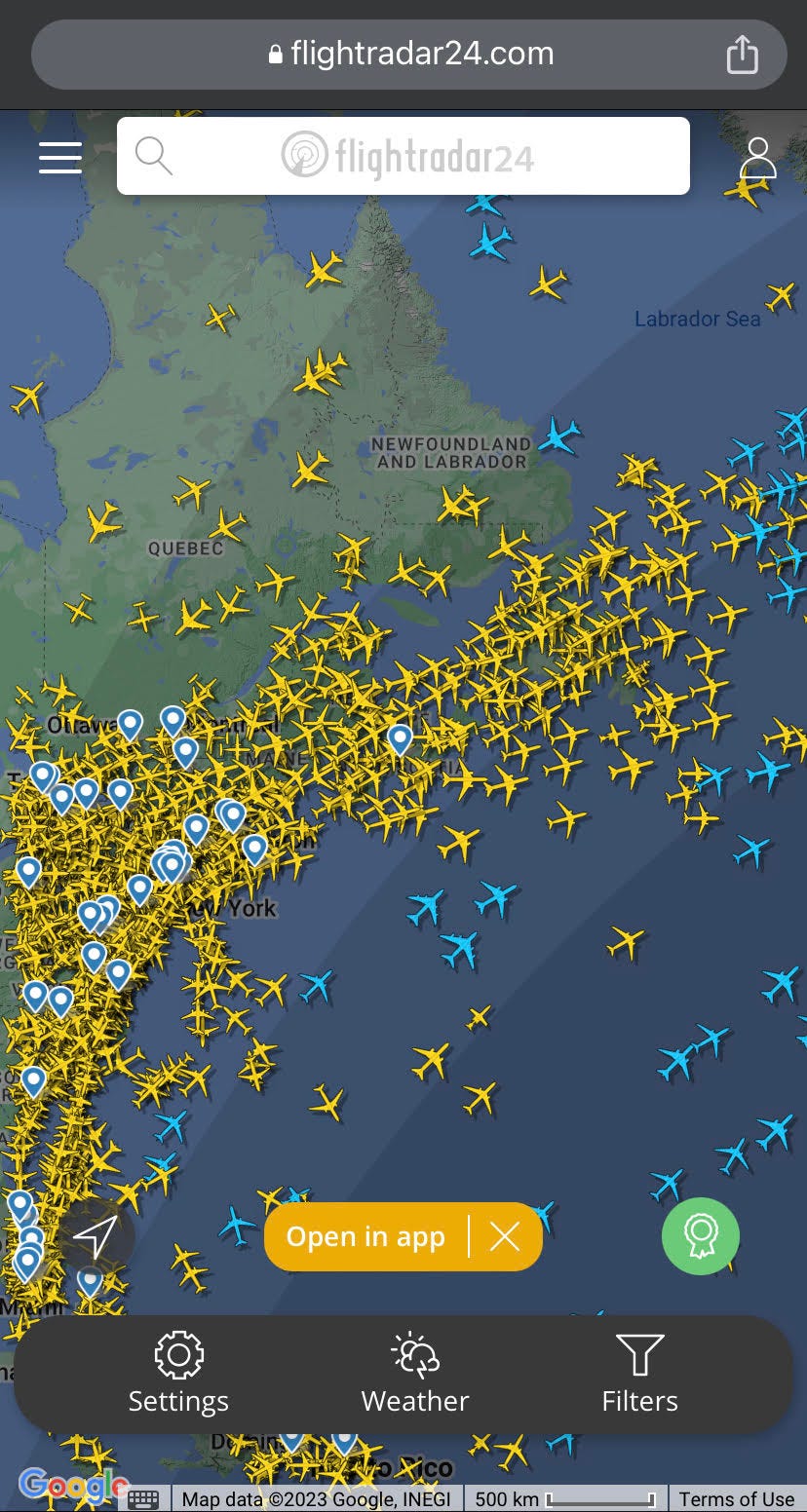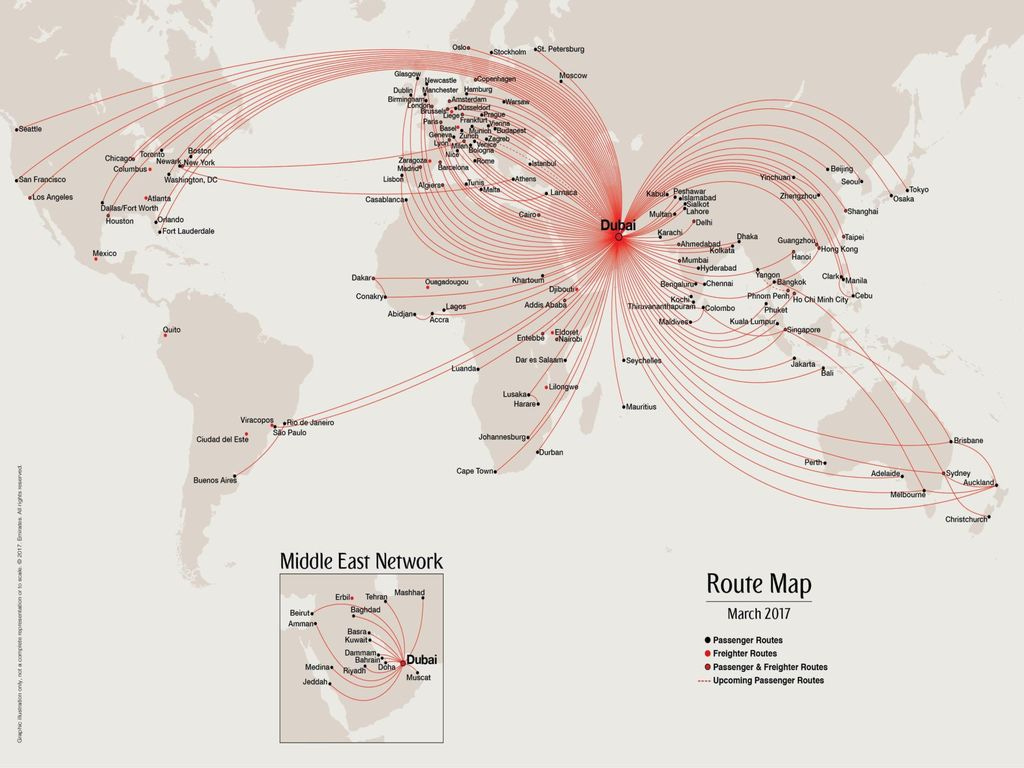Every night around 10pm, a group of planes leave North American airports for Europe, and taking their lane on a highway across the Atlantic. Because the earth is round, and to manage heavy traffic with limited radar, planes are assigned a lane every night, which they enter just off the coast of Newfoundland and exit approaching Ireland.
A few nights ago, I screenshotted flightradar24.com’s live flight tracking. You can see the mass of flights over the U.S., and a funnel as they prepare to cross the Atlantic.
See those blue markers? Those are airports. See that lonely marker, out - seemingly in the middle of the Atlantic - by itself? That’s Halifax’s Stanfield airport (YHZ).
To see it more clearly, I’ve mapped the shortest routes from 4 U.S. east coast airports and 4 European destinations (note: these aren’t flight routes, just the shortest line).
The shortest possible routes for all routes cross Nova Scotia. That’s pretty convenient for a stop over. And coordinated stopovers (when organized as a hub), can completely change an airports potential.
So lets draw this out:
As individual flights, each route would independently need enough market demand to justify the cost of the route. So you need to find enough New Yorkers who want to go to London (easy but highly competitive), and Atlantans wanting to go to Dublin, and Charlotteans wanting to go to Frankfurt, etc. Each point operates independently and needs to be profitable independently.
But, what if you added a stop in Halifax? It’d be a hassle for sure. Deboarding and reboarding is a time waster, but the logistics change completely. Assuming good flight scheduling, someone from Atlanta could take their first leg from Atlanta to Halifax, then get on the flight destined for Paris.
You don’t need to fill each route individually anymore. You just need to find 200 people from Atlanta wanting to go to one of London, Paris, Frankfurt or Amsterdam. In reverse, Londoners wanting to go to New York, D.C., Atlanta or Charlotte are now potential customers. The addressable market increases exponentially.
Best of all for Haligonians, our flight options would expand dramatically. As a small city, we are unlikely to ever have enough local demand to locally support many transatlantic flight options1. But we could act as a transatlantic first-stop/ last-stop hub, taking advantage of our unique geography.
There are other advantages, two shorter flights can often have to carry less fuel than one long flight. Shorter flights can also use smaller aircraft, lowering the upfront investment cost and the bar for how many tickets need to be sold.
For example, Air Canada’s direct flight to London from Halifax uses the 737MAX-8, which seats about ~180 passengers. From Halifax it can reach most European destinations outside of southern Italy. From New York, the 737MAX-8 can just barely reach London, and little of continental Europe. Being able to reach Los Angeles and Berlin with the same (smaller) aircraft provides great flexibility.
X Marks the spot
Many airports and airlines have leveraged their geography to be airport hubs. The most famous is probably the middle east carriers like Emirates. Dubai’s location between Europe and Asia makes it a logical long-haul hub.
Obviously, we shouldn’t do stuff just because the oil producers of the middle east are. But the point is there are many cases where geography is a key pillar of an airlines / airports strategy. Off the top of my head:
Iceland’s air carriers have used almost this exact strategy (even though Iceland is more out of the way as a stopover)
Avianca in Colombia serves as a stopover point for travel between North and South America
Helsinki airport once aimed to be a hub for European travel to China (flying from Europe to China, you go north, and cross Finland on the way)
Japanese carriers have acted as hubs for transpacific trips, especially for Korean and Chinese flyers
The Icy Cold Water
Given Halifax’s geographic advantage, our airport performance is lackluster. Airport traffic grew at 0.9% per year from 2008 to 2019, less than half the national average.
COVID recoveries are ongoing for airports, but recent signs are not good. This year, Westjet all but abandoned Halifax, cutting all of its European summer routes (London-Gatwick, Dublin, Glasgow and Paris). Halifax now has only two European flights, Air Canada to London Heathrow and Eurowings to Frankfurt.
Why the gap between our potential and reality?
Operating airlines is always difficult, but I’d mostly point to regulation. First, foreign airlines are not allow to fly into Canada and continue onward, either domestically or another country2. Canadian airlines cannot be majority controlled by foreign capital either.
For Halifax, that means airlines would need to find Canadian funding to go against a near monopoly in Air Canada, without be able to leverage any helpful hub structures. No wonder we need to fly to Toronto first to go most places.
The federal government should really consider special exemptions for Atlantic Canada. The reasoning behind our super protected airline industry is that the extra profits on good domestic routes (like Toronto-Montreal, or for us Toronto-Halifax) would help subsidize regional money losers like Halifax-Sydney. But those regional routes are gone, and all that’s left is price gouging domestic service.
This is also dependent on regulations
I’m way out of my depth here, but I’d wager you could get Ryanair to fly from Dublin to St. John’s or Halifax, if they could continue on to Toronto as well.









Eye opening Deny,
Dollar Bills Flying Over Us!
Now we just have to get it to "land" on us!